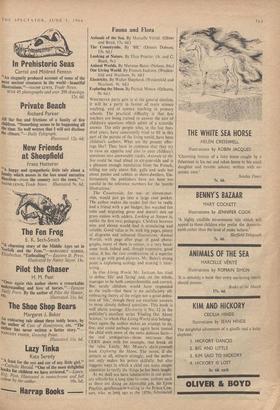Fauna and Flora
WHICHEVER party gets in at the general election, it will be a party in favour of more science teaching, and of science teaching in primary schools. The practical difficulty is that few teachers are being trained to answer the sort of children's questions which admit of a scientific answer. The only people who, in the last hun- dred years, have consistently tried to fill in this part of the picture of the living world, have been children's authors. What are the present offer- ings like? They have in common that they try to raise an appetite and also to steer children's questions into answerable tracks. Animals of the Sea could be read aloud to six-year-olds and is a pleasant enough translation from the French, telling not only about fish, gulls and seals but about ponies and rabbits as shore-dwellers. Un- fortunately the publishers have not been too careful in the reference numbers for the 'puzzle illustrations.'
The Countryside, for ten- or eleven-year- olds, would just go into a large coat pocket. The author makes the reader feel that he really had a friend with a pet badger, has watched fox cubs and migrating geese and doesn't mix up grass snakes with adders. Looking at Nature is, unlike the first two, pedagogic. Children between nine and eleven would find it stimulating and reliable. Good value at 9s. with big pages, plenty of diagrams and coloured illustrations. Animal Worlds, with page after page of good photo- graphs, many of them in colour, is a very hand- some book indeed and, though expensive, good value. It has the rare combination of a superior text to go with good pictures. Mr. Bates's strong point is explaining ecology and making it inter- esting.
In Our Living World Mr. Jackson has tried to define 'life' and 'living' and, on the whole, manages to be both comprehensible and correct. But surely children would have responded to the truth-that there is no satisfactory all- embracing theory of the origin nor a good defini- tion of 'life,' though there are excellent answers to more closely defined questions. This book is well above average. Electricity is No. 12 in the publisher's excellent series 'Finding Out About Science,' to which Our Living World also belongs. Once again the author makes an attempt to de- fine, and could perhaps once again have trusted the child with more of the more dubious facts- the real ambiguities-7those nutrinoes that CERN deals with for example, that break all the rules. Lastly, Mr. Moore's do-it-yourself book Exploring the Moon. The moon, if she attracts at all, attracts strongly, and the author not only makes his points skilfully, but also suggests ways in which a child can make simple apparatus to verify the things he has been taught.
As we shall not have laboratories in our prim- ary schools for a long time to come, authors such as these are doing an admirable job. Sir Lyon Playfair, gentleman-in-waiting to the Prince Con- sort. who, as long ago as the 1870s, fulminated against the failure to teach science to children under thirteen, would have liked this batch of books: `The whole yearnings of a child,' he wrote, `are for the natural phenomena around, and yet of these, as soon as he comes into the schoolroom, he is taught nothing.' He writes with a warmth that is positively ungentlemanly. 'Children are crammed with facts which they vomit forth be- fore the examiner.' Such teaching is 'ignoble.' The child must not be forced into passivity but should 'pull the plant to pieces . . . see water broken up into its constituent parts . . . and vex the electrical cylinder until it yields him its sparks.' Did anyone heed Playfair? Only the children's authors.
AMABEL WILLIAMS-ELLIS







































 Previous page
Previous page